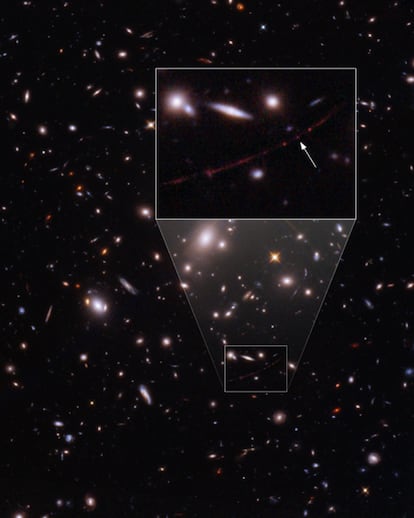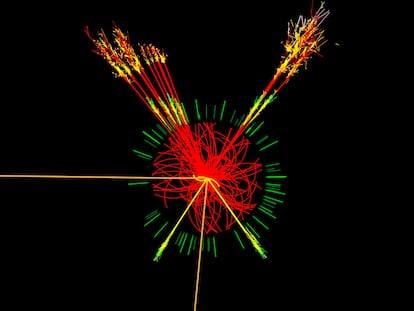What will happen to Earendel, the farthest star ever observed?
General relativity, optics, the concept of time, all come together in this celestial object’s story, the end of which has been written, but has not yet passed

Let’s imagine we are in a soccer stadium. Choose your favorite one: mine is the Santiago Bernabéu stadium in Madrid. I’m sitting in my seat as the Real Madrid soccer club tries to make a comeback. The team’s midfielder Luka Modrić has the ball. Something is going to happen! Everyone can sense it. The spectator in front of me gets excited and starts to stand up from his seat. I don’t want to miss what happens, so I have to move too so he doesn’t block my view. Modrić passes the ball to Karim Benzema who kicks it to Vini Jr... The man in front is now standing on his feet with his arms in the air, and he’s huge! A few tenths of a second and… the man in front, perfectly aligned between the game and my seat, has blocked my view. I missed what happened!
What does this story have to do with Earendel, the farthest star ever observed? Let’s imagine Vini is a young and distant star named Earendel (the Old English name for “morning star”), and the big man blocking the view is a cluster of galaxies called WHL0137-08 (named WHL after the astronomers who discovered it: Z. Wen, J. Han and F. Liu). In this scenario, I am still the observer. We are all doing our own thing, when at a precise and special moment, we come into alignment. In the example of the soccer game, I can’t see what’s going on on the field: the man in front eclipses the view, even if he isn’t standing right in front of me.
But in the real universe, something fascinating happens. In the stadium, some rays of light come out of Modrić, Benzema and Vini, go around the man in front and reach the spectators to my left and right or in the row above me. The rays going straight towards me don’t make it. As NASA revealed last week, the cluster between us and the star Earendel is so massive, that it curves space-time. Therefore, the light rays that should never have reached us, because they went in another direction to us, follow a path in that curved space that finally leads them to our eyes. The result is not only that we can see the image of the distant star, but that it becomes brighter and spatially amplified! It is as if – thanks to the tall man – we can see the game in much brighter and much greater detail; we are able to distinguish even a single blade of grass from our seats.
This phenomenon is very similar to what many of us did as children: use a magnifying glass to burn a piece of paper. If we align the magnifying glass, the Sun and the paper and if, in addition, the relative distance between the Sun, the magnifying glass and the paper is correct, the magnifying glass brings a multitude of light rays to a very small area that would have been scattered all over the paper. It concentrates the light, creates a super bright image on the paper, its energy is greater and, in the end, it burns the paper. Also, as we all know, magnifying glasses enlarge the apparent size of objects. The same happens with our cluster. When perfectly aligned and at the right distance from the observer and distant object, the cluster concentrates the energy coming from Earendel in a way that allows us to see the faint things that we would not have been able to detect with our small and limited telescopes.
The cluster between us and the star Earendel is so massive, that it curves space-time
The analogy goes further, to burn the paper with our magnifying glass, we had to focus it and in the process, we were able to see much brighter areas, sometimes in distorted ways. That is what is called a caustic – the envelope of light rays reflected or refracted by a curved surface or object. And this is how Earendel has been found, at maximum amplification. The cosmic magnifying glass that has allowed us to see Earendel can make objects look at least 1,000 times bigger and even 40,000 times bigger. The typical magnifying glass of our childhood can only enlarge objects by up to 50 times.
The cluster is thus a great cosmic magnifying glass, or, as astrophysicists often call it, a gravitational telescope, concentrating the light of faint and distant objects and allowing us to see the universe in spectacular detail. A cosmic event like the discovery of Earendel, or that of Icarus a few years ago, allows us to ask a couple of very interesting questions. What is the cluster causing the gravitational effect like? And what is that faraway star we are seeing? Today we will focus on the second question.
In the Milky Way, it is very difficult for us to find very massive stars, because they don’t have a long lifespan. What’s more, they appear in areas of recent star formation where there is often so much material around that they remain hidden, overshadowed by clouds of gas and dust, making finding them highly unlikely. In nearby galaxies, we have more opportunities, but we run into the problem of spatial resolution, since what we see from other galaxies is almost always a diffuse set of stars that we cannot distinguish individually, even with the most powerful telescopes. It is true that massive stars can stand out so much, be so bright compared to other stars around them, that they can even be discerned in galaxies such as Andromeda or the Triangulum galaxy, about 2.5 million light-years away. But we can count the number of massive stars we have found on one hand. So detecting a massive star (or its binary, massive stars are almost never alone) that formed when the universe was only 6% of its current age is mind-boggling! And it’s even more fascinating to think that part of the photons we see traveled about 0.2 billion light-years after seeing practically the entire universe. While the universe was expanding, some of these photons traveled even further, because they took a (small) turn to reach us – their trajectory was a curve.
What’s even more incredible is that what happened to Earendel will actually happen in our future. I’m sorry, but a massive star won’t last for more than a few million years. Indeed, some say that the star no longer exists because it exploded as a supernova, but we could also say that we will see that explosion “live” (as much as this is possible within the physics of the universe) within “a few years” – it could happen in a few million years, if the star was very young, or maybe tomorrow if the star was already near the end of its life. Before this happens, the star’s image may even begin to double or distort. This will happen when its motion, which can typically reach 621 miles (1,000 kilometers) per second, or ours, which is about 155 miles (250 km) per second around the center of the Milky Way, or whatever happens in the cluster, blurs Earendel’s image, which may disappear from view. We will be on alert for everything that has happened in the star’s past, only we will be seeing it in our present.
Tu suscripción se está usando en otro dispositivo
¿Quieres añadir otro usuario a tu suscripción?
Si continúas leyendo en este dispositivo, no se podrá leer en el otro.
FlechaTu suscripción se está usando en otro dispositivo y solo puedes acceder a EL PAÍS desde un dispositivo a la vez.
Si quieres compartir tu cuenta, cambia tu suscripción a la modalidad Premium, así podrás añadir otro usuario. Cada uno accederá con su propia cuenta de email, lo que os permitirá personalizar vuestra experiencia en EL PAÍS.
¿Tienes una suscripción de empresa? Accede aquí para contratar más cuentas.
En el caso de no saber quién está usando tu cuenta, te recomendamos cambiar tu contraseña aquí.
Si decides continuar compartiendo tu cuenta, este mensaje se mostrará en tu dispositivo y en el de la otra persona que está usando tu cuenta de forma indefinida, afectando a tu experiencia de lectura. Puedes consultar aquí los términos y condiciones de la suscripción digital.
More information
Últimas noticias
The complicated life of Francesca Albanese: A rising figure in Italy but barred from every bank by Trump’s sanctions
Half of Scotland is in the hands of 420 property owners
Pinochet’s victims grapple with José Antonio Kast’s rise in Chile
Reinhard Genzel, Nobel laureate in physics: ‘One-minute videos will never give you the truth’
Most viewed
- Pablo Escobar’s hippos: A serious environmental problem, 40 years on
- Why we lost the habit of sleeping in two segments and how that changed our sense of time
- Charles Dubouloz, mountaineering star, retires at 36 with a farewell tour inspired by Walter Bonatti
- Reinhard Genzel, Nobel laureate in physics: ‘One-minute videos will never give you the truth’
- The Florida Keys tourist paradise is besieged by immigration agents: ‘We’ve never seen anything like this’











































